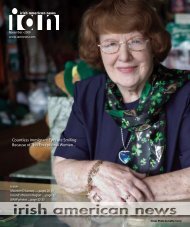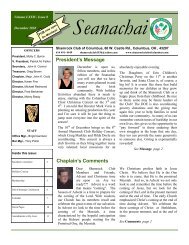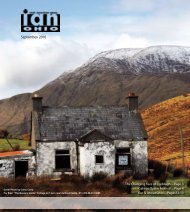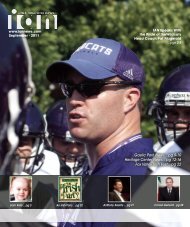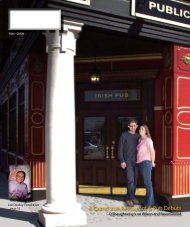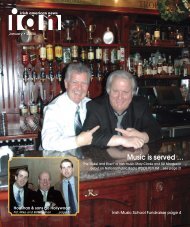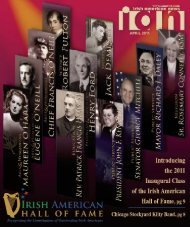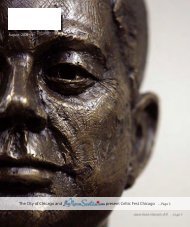July • 2006 IMSC students take a back seat - Irish American News
July • 2006 IMSC students take a back seat - Irish American News
July • 2006 IMSC students take a back seat - Irish American News
You also want an ePaper? Increase the reach of your titles
YUMPU automatically turns print PDFs into web optimized ePapers that Google loves.
<strong>July</strong> <strong>2006</strong> IRISH AMERICAN NEWS 5<br />
T<br />
inker’s<br />
Dam<br />
by Fr. Kevin O’Neill Shanley<br />
<strong>Irish</strong> naval hero Jeremiah 0’ Brien and<br />
World War II U.S. Liberty Ships<br />
Introduction<br />
They were called the “ugly ducklings”<br />
of World War II but the 2,750<br />
Liberty ships built by the United States<br />
helped to keep open the vital shipping<br />
lifelines that enabled America to supply<br />
its vast Armed Forces and those of its<br />
Allies around the globe and eventually<br />
emerge victorious over the Axis<br />
Powers. They were the<br />
brainchild of U.S. industrialist<br />
Henry Kaiser of<br />
assembly—line and prefabricated<br />
ships which<br />
could be built in a matter<br />
of weeks, and eventually<br />
in a matter of days.<br />
But mostly they were<br />
America’s answer to the<br />
German U—boats which<br />
were sinking thousands<br />
of tons of Allied merchant<br />
ships and threatening<br />
the Allied war eff ort<br />
with defeat in World War<br />
II.<br />
Early Experience<br />
As a young boy, this writer well<br />
remembers the building and launching<br />
of the Liberty Ships at the Federal<br />
Shipbuilding and Drydock Company<br />
across Newark Bay in Kearney, N.J.<br />
Years later, sailing up the Hudson River<br />
on excursion boats to Bear Mountain<br />
in New York State, our group passed<br />
large gatherings of them moored<br />
together in the ghostly spectres of our<br />
“mothball” fl eet.<br />
And now the ships mass—produced<br />
between 1941-45 are all gone except<br />
for the “Jeremiah O’Brien” which was<br />
re-furbished and saved for posterity on<br />
the waterfront of San Francisco Bay<br />
in California. It stands proudly today<br />
in the U.S. Maritime Museum with<br />
other naval ships. It is both a national<br />
monument and a reminder of the largest<br />
merchant ship—building program<br />
in naval history.<br />
Why the “Jeremiah O’Brien?<br />
But why was the “Jeremiah O’Brien”<br />
selected? The answer is simply part<br />
‘<strong>Irish</strong>’ luck and part determination.<br />
Thomas Patterson, Jr., regional director<br />
of the U.S. Maritime Administration in<br />
San Francisco, founded the National<br />
Liberty Ship Memorial group to dedicate<br />
some type of a monument to the<br />
builders, seamen, troops and all those<br />
who were part of the Liberty Ship saga<br />
during and after World War II.<br />
Enough was known about the<br />
“Jeremiah 0’Brien” to insure that it<br />
was a fi tting symbol to represent all<br />
the Liberty Ships. Built in 1913 by the<br />
New England Ship Building Corporation<br />
in Maine, it hadn’t been changed in<br />
any way since the day it was launched.<br />
Its ship log shows that the “Jeremiah<br />
O’Brien” served in both the European<br />
and Asian theaters of war, even participating<br />
in the D—Day Invasion at<br />
Omaha Beach In Normandy, France on<br />
June 6, 1944. It proved to be a gallant<br />
ship and crew.<br />
But with the surrender of Japan in<br />
August of l945, there was less need for<br />
the famous Liberty Ships, and so the<br />
“Jeremiah O’Brien” and many others<br />
were assigned to the Reserve Fleet at<br />
Suisum Bay in California.<br />
As the Libertys were sent one by<br />
one to the scrap heap, Patterson and<br />
others decided to select one Liberty as<br />
an historical reminder of a great period<br />
in U.S. Naval History. The “Jeremiah<br />
O’Brien” was chosen because, as far<br />
as it could be determined, it is the last<br />
stock Liberty, with no alteration or<br />
modifi cation of its design.<br />
Who Was Jeremiah O’Brien?<br />
But who was the original Jeremiah<br />
O’Brien after whom the ship was<br />
named? Although much praise is<br />
deservedly given to Commodore John<br />
Barry of Wexford as the “Father of the<br />
<strong>American</strong> Navy,” the honor of leading<br />
the very fi rst ships into battle must go<br />
to Jeremiah O’Brien even before the<br />
<strong>American</strong> Revolution had formally<br />
begun.<br />
The son of a Corkman, Jeremiah<br />
O’Brien and his five intrepid sons<br />
were fi shermen in the State of Maine.<br />
On June 12, l775, off the coast of Machias,<br />
Maine, Jeremiah<br />
led his sons and other<br />
local patriots in their<br />
fi shing boats to capture<br />
the British schooner<br />
“Margaretta” as the<br />
first <strong>American</strong> “prize<br />
of war.”<br />
And when the infuriated<br />
British sent two<br />
warships from Boston<br />
to punish the rebel upstarts<br />
and re-capture the<br />
“Margaretta,” Jeremiah<br />
O’Brien and his “navy”<br />
obliged by capturing the<br />
two British ships, too.<br />
So, it is fi tting that<br />
the “Jeremiah O’Brien” should stand<br />
not only for an early naval hero but<br />
also for the thousands of ships which<br />
helped to bring liberty to a war—torn<br />
world in the l940s.<br />
“Ugly Ducklings” Name<br />
It was actually U.S. President<br />
Franklin Roosevelt who dubbed the<br />
ships as “ugly ducklings” as a term of<br />
admiration and aff ection for their great<br />
wartime service. Although the ships<br />
were not beautiful at all in a design<br />
sense, they were sturdy and dependable.<br />
Their crews, though living in very<br />
uncomfortable quarters, felt they were<br />
making a signifi cant contribution to<br />
the Allied war eff ort. With an over-all<br />
length of 441 feet 6 inches, a beam of<br />
57 feet, and a depth of 37 feet 4 inches,<br />
the Libertys had a total displacement<br />
of 14,000 tons and could carry nearly<br />
10,000 tons of cargo. To aff ect mass<br />
production, the ships were welded<br />
together rather than riveted.<br />
The fi rst Liberty Ship, the “Patrick<br />
Henry,” was launched in Baltimore,<br />
Maryland on Sept. 27, l94l amid little<br />
fanfare.<br />
It and thousands of others were<br />
Americas answer to the U-boats which<br />
were sinking cargo ships faster than<br />
they could be built. But within a year<br />
Liberty Ships were being built in 3<br />
1/2 months, and by 1943 three Liberty<br />
Ships a day were being completed.<br />
The battle of the sealanes in World<br />
War II was won by the Libertys and<br />
the men and<br />
women who built and sailed by<br />
them.<br />
Fitting Memorial<br />
And now there is only the “Jeremiah<br />
O’Brien” left to represent the saga of<br />
the Libertys of World War II. The U.S.<br />
National Park Service planned a site for<br />
the ship in the Golden Gate National<br />
Recreation area in San Francisco. Piers<br />
were constructed between the city’s<br />
famous Fisherman’s Warf and Fort<br />
Mason as a fi tting shrine to a great<br />
ship that represents so many others.<br />
By any measurement, the Liberty<br />
Ship program was an extraordinary<br />
feat in a time of great need. It is more<br />
than fi tting that the ship should bear<br />
an <strong>Irish</strong> name to remind many of their<br />
contributions to Liberty.







